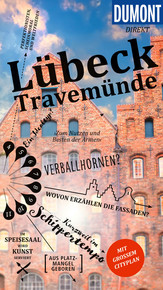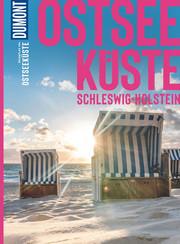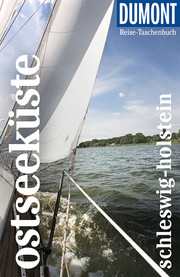Lübeck, the small Hanseatic pearl on the Baltic Sea, captivates not only with its old town island completely surrounded by water and the famous Holstentor gate, but also with its narrow winding alleys adorned with cozy cafes, old warehouse and merchant houses in Brick Gothic style, seven church towers, the old museum harbor, and well-preserved city gates. It's no wonder that this northern German city has been a UNESCO World Heritage Site since 1987. Moreover, marzipan enthusiasts will find plenty to indulge in Lübeck.
Founded in 1143, Lübeck long served as a model for all Hanseatic cities in the entire Baltic Sea region. Due to its location on the Trave River, the city developed into a Northern European center of power during the Middle Ages. After the first Hanseatic capital of Visby, located on the island of Gotland, was conquered by the Kingdom of Denmark in 1361, Lübeck rose to become the "Queen of the Hanseatic League." The city maintained this role as a trading powerhouse until the 16th century. And today? The Queen of the Hanse is old, but not outdated. The historical old town, resembling an open-air museum of Brick Gothic architecture, impresses with its overview and compactness, making it ideal for exploration in a day. Designated as a UNESCO World Heritage Site since 1987, the historic core of the old town with its seven church towers is situated on an island, surrounded by the Trave River and the Elbe-Lübeck Canal.
At the entrance to the old town stands the symbol and arguably the most famous building of the city, the Holstentor. Once featured on the German 50-mark banknote, it was even used by Andy Warhol in his pop art. In the Middle Ages, the renowned city gate served for defense and projected Hanseatic power with its formidable appearance. The gate once featured a mechanism called the "orgelwerk," which allowed individual iron bars to be lowered instead of all at once. This ensured that in the event of an attack, defenders could pass through before the final one or two iron bars were lowered. Photo tip: The late afternoon sunlight falls on the Holstentor, creating a perfect panoramic image of the old town.
Not far from the Holstentor, the next historic building awaits to be showcased by you. The Old Gothic Town Hall, one of the largest town halls in Germany at the time of its construction, impresses not only externally with its beauty but also with the grandeur of its audience hall. An interesting detail: the courtroom has both a high and a low door. The acquitted individuals would exit through the high door, while the convicted would leave the courtroom with their heads bowed through the low door.
For those without a fear of heights, we recommend the panoramic view from St. Petri Church. From the covered observation platform at a height of 50 meters, the 360-degree view stretches over the historical old town, the numerous gables of patrician houses, excursion boats.
During further strolls through the old town, you'll walk on cobblestone streets, winding through narrow alleyways, and passing by idyllic courtyards. If you pay attention to street names, you'll immediately notice another curiosity: in Lübeck, you can stroll from Purgatory to Hell, luckily the ground doesn't actually burn ;-) !
If you have a bit more time, I recommend two museums at this point: those fond of maritime life can admire old traditional sailing ships and supply vessels at the museum harbor while taking a walk along the Untertrave. Most of the historical ships are located between the pedestrian bridge and the swing bridge. In total, there are over twenty of them that are still seaworthy today, and you can even sail on them on certain occasions. Popular photo motifs include the "Fehmarnbelt" lightship, which served as a floating lighthouse until 1984, and right next to it, the "Lisa von Lübeck," a replica of a medieval ship.
The European Hanseatic Museum is worth a visit, even on a gloomy North German day. The museum takes you through the history of the Hanseatic League; many things can be touched, smelled, and tried, while digital offerings provide modern and engaging knowledge transfer. Part of the exhibition also features one of the most significant monastery complexes in northern Germany, where you'll feel like you've stepped out of time a bit.
Feeling hungry for lunch? Here's a tip: stop by the Kartoffelspeicher, right by the Trave. Here, not far from the Holstentor, everything revolves around the good old potato. The menu offers baked potatoes with creative toppings - Mediterranean, Mexican, classic, and much more. A great spot for a quick and delicious lunch!
After being well-fed, you'll continue your journey through Hüxstrasse. This charming shopping street entices with over 100 craft businesses and galleries and ends at the marketplace, where the Buddenbrook House awaits your visit. Here, you'll learn all about Thomas Mann and his merchant family. Lübeck takes pride in its famous citizens. Thus, the Günter Grass House offers you a comprehensive overview of the complete works of the Nobel Prize-winning author, including books, graphic works, and sculptures, while the Willy Brandt House traces the life path of the native Lübecker and Nobel Peace Prize laureate through a multimedia exhibition.
However, far more famous than Mann, Grass, and Brandt combined is Lübeck marzipan. In 1803, Georg Niederegger arrived in Lübeck and made this sweet confection made from ground almonds and sugar famous worldwide through his traditional company, Niederegger. Originally from the Orient, marzipan was shipped to Europe through Venice. For a long time, it was exclusively made by nuns and pharmacists and was considered a remedy for headaches and heartaches. If you want to learn more about this sweet temptation, Lübeck is the perfect place. At the Niederegger Marzipan Museum, visitors will gain valuable insights into the history of marzipan – from raw materials and trade to the company's history. After so much theory, it's time for some practical experience: at the café of the Niederegger headquarters on Breite Strasse, you can enjoy perhaps the best marzipan cake in town, and in the attached shop, you'll find sweet souvenirs to take home.
After a day filled with impressions, your stomach will surely remind you of its presence. The Hanseatic way to satisfy your hunger is offered by the Schiffergesellschaft restaurant. Boats and chandeliers hang from the ceiling, benches are adorned with wood carvings, and the walls are so decorated that you won't know where to look first. The menu features Northern German home-style dishes like Labskaus, freshly caught sea fish, and also vegetarian options. Or how about "The Newport," a stylish and modern restaurant with a conservatory, where you can observe in a relaxed atmosphere as darkness slowly descends over the old town, while the people of Lübeck moor their boats. The menu is concise but excellent. My recommendation: the Holsteiner beef fillet with fig-pepper crust, paired with a glass of Lübecker Rotspon, a Bordeaux wine from the region. The wine barrels were originally delivered from France and matured in Lübeck. Definitely a must-try!
For those who still have plenty of energy, you can explore the streets of Lübeck at night. Lübeck's nightlife offers many cultural options. In summer, when long days and magnificent sunsets await, the "Strandsalon" is perhaps the most beautiful place for a sundowner. At the city beach on the northern Wallhalbinsel peninsula, you can dance away the balmy nights.
Live music can be enjoyed at "Tonfink," which transforms from a café with delicious cakes in the afternoon into a cozy bar and cultural venue in the evening, hosting concerts, readings, and cabaret.
And if you long for the sea the next morning: the train will take you to Travemünde on the Baltic Sea in just 30 minutes. You can even reach Timmendorfer Strand, also a popular destination, in a quick 15-minute train ride. Rent a beach chair and listen to the waves. Isn't that wonderful !?!

To properly prepare for your trip
How to get there:
By train or with your own car
How long to stay:
Weekend - easily combinable with a Baltic Sea vacation
Best time to travel:
Year-round
Highlights:
Holstentor, Niederegger Marzipan, Salt Warehouses, and Brick Romanticism
Culinary delights:
https://schiffergesellschaft.de
https://www.the-newport.de
For night owls:
https://www.strandsalon.de
Accommodation tip:
https://www.motel-one.com/de/hotels/luebeck/hotel-luebeck/
More information:
www.luebeck-tourismus.de
Realised by Michael Bachmann
Further travel pictures under www.kissed-by-nature.com















